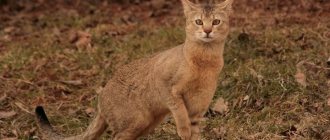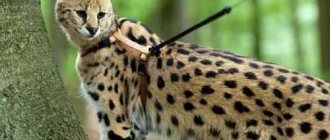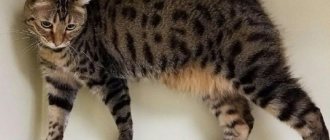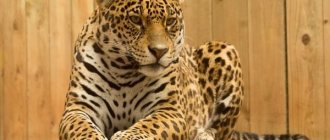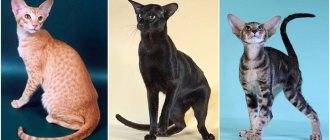The margay is one of the most beautiful and mysterious spotted cats in America. In size, this predator is closer to tiger cats, but in appearance it resembles an ocelot and an oncilla, which have a similar pattern and coat color. In some parts of South America, the margay is even called the "little ocelot" .
Remember Puss in Boots from Shrek? If his eyes seemed incredibly large and beautiful to you, you should meet the main character of our story today to make sure that cats with such eyes actually exist.
Scientific classification
- Kingdom: Animalia (animals)
- Phylum: Chordata
- Class: Mammalia (mammals)
- Order: Carnivora (predatory)
- Family: Felidae (felines)
- Genus: Leopardus (South American cats)
- Species: Leopardus wiedii (margay, long-tailed cat)
The specific name "wiedii" was given in honor of the German naturalist Prince Maximilian Wied-Neuwied, from whose collection the species was described. The name "margay" was first used by the naturalist Buffon. It comes from the word "rnaragao" used by a traveler to describe a cat. This word, in turn, probably comes from the Guaranese word "mbaracaya", which means "wild cat".
Number of species leopardus jacobita
Naturalist researchers suggest that the number of Andean cats does not exceed 2,500 individuals. The natural enemies of these animals are unknown, but there is evidence that humans played a negative role in reducing the number of the species. One version of why this happened is that the Andean people began to die out due to insufficient food. People exterminate rodents that wild predators feed on. In particular, chinchilla fur has long been highly valued on the world market.
The Andean cat is one of the rarest species that inhabit South America. The species is listed in the International Red Book. Appendix I of the CITES Convention contains a list of all rare animals, and the Andean cat is listed on the most restrictive list of the appendix. According to the document, trade in this species is strictly prohibited.
In 2004, the Alliance for the Study and Conservation of the Andean Cat was created. The alliance includes conservationists from Argentina, Bolivia and other countries where cat tracks were found. Perhaps a solution will soon be found to how to preserve and increase the numbers of this most mysterious of species.
The Andean cat is a wild carnivore from the cat family. This is a small animal that has the most inconspicuous appearance. The Andean cat can blend in with nature thanks to its talent for camouflage. Such animals can be called survival specialists, because they have to hide, feed and reproduce in the harshest climatic conditions. No matter how hard people tried, they were unable to tame such an animal. This animal cannot survive in the conditions offered by man. In addition, buying and selling a cat of a rare species is considered a crime.
Varieties
Photo: Malene Thyssen
There are currently ten known subspecies of long-tailed cats:
- Leopardus wiedii amazonicus – western Brazil, southeastern Peru, southern Colombia, southern Venezuela, eastern Ecuador;
- Leopardus wiedii boliviae – Bolivia;
- Leopardus wiedii cooperi – northeastern Mexico (Nuevo Leon state);
- Leopardus wiedii glauculus – central regions of Mexico;
- Leopardus wiedii oaxacensis – southern Mexico;
- Leopardus wiedii nicaraguae – Nicaragua, Costa Rica and Honduras;
- Leopardus wiedii yucatanicus – Yucatan Peninsula;
- Leopardus wiedii pirrensis – Peru, Ecuador, Colombia and Panama;
- Leopardus wiedii salvinius – Chiapas (Mexican state), Guatemala, El Salvador;
- Leopardus wiedii wiedii – Latin America south of the Amazon.
Spread range
The margay inhabits tropical forests in southern Mexico, Central America and northern Latin America, east of the Andes. Its southern distribution range includes Uruguay and northern Argentina.
Photo: Chermundy
Natural habitat
Compared to other tropical American cat species, margays are strongly associated with forest habitats and live primarily in tropical and subtropical evergreen jungle, deciduous/semi-deciduous, moist piedmont and coastal forests. In open areas, such as wet swampy savannas, the long-tailed cat usually sticks to gallery forests. Only rarely have sightings been reported outside of forested areas.
Although margays appear to be less tolerant of disturbance than other small wild cats, they sometimes use modified habitat such as secondary forests, agricultural plots, abandoned corn fields, and shady cocoa and coffee plantations. The altitudinal gradient ranges from 0 to 3000 meters above sea level .
Interesting fact! As the largest and most adaptive of the small South American cat species, the ocelot dominates other small cat species. In areas where the ocelot occurs, species such as margays avoid them due to the threat of attack and competition for prey. This negative effect on other small cat species is called the "ocelot effect" . When ocelots inhabit protected areas, smaller cats may be driven into adjacent unprotected areas where the threat of habitat loss and interaction with humans is greater.
- Biogeographic regions: Central and South America
- Habitat: temperate, tropical
Home range
Margays are rare throughout their range and in very few areas can they be considered relatively common. The average population density is from 1 to 5 individuals per 100 km² . Only in a few areas the density of long-tailed cats reaches 15-25 individuals per 100 km².
Photo: leithalb
A radiotelemetry study conducted in Brazil over 18 months showed that the distance between the “houses” was 16 km². Researchers from the El Cielo Biosphere Reserve in northeastern Mexico captured 15 individuals, indicating high numbers of margay. The four males in the study were found to have an average home range of 4.03 km², and their ranges overlapped by 29%. The home territory for one female was 0.96 km². Each cat had a home area that was approximately half the size of their home range. Apparently, the high abundance in the study area may be due to the lack of ocelot in this quality habitat.
Keeping the Andean cat in captivity
For the freedom-loving Andean cat, living in captivity is not possible. All attempts to keep her in zoos ended sadly - not a single animal, even with the best care, could survive there for more than a year. For a predator accustomed to vast open spaces and fresh winds, the musty air of enclosed spaces is destructive.
Captive breeding programs for endangered species, which have long been effective in increasing the numbers of many other rare animals, are unfortunately unacceptable for the Andean cat.
Captivity is a quick death for the Andean cat
This species is not kept in any zoo in the world . There is no information that Andean cats are present in any of the private collections of exotic animals, despite the strange fashion for home zoos and rare predators. It is impossible to legally purchase Andean kittens or adults - trading in representatives of this species is illegal and entails criminal liability for the seller.
If some specimens are smuggled into private ownership, they are absolutely not amenable to domestication, and soon become ill and die. Born free, this little hut can and should live only in the wild, in its natural habitat - on the high mountain slopes of the harsh Andes.
Character traits
Appearance
The margay has thick and soft fur . Hair length ranges from 13 to 27 mm on the back and from 7 to 18 mm on the back of the head. There is individual variation in coat pattern. Overall, the upperparts range from pale yellowish-grayish to rich buffy brown and dark brownish buffy, fading towards the lower sides. The belly, chest, throat, chin and inside of the legs are whitish in color.
Photo: Jorge Campos
Additionally, there is variation in the pattern of the spots, ranging from narrow striped spots to large, irregularly shaped round rosettes with black or dark brown rims and centers darker than the base color. The rosettes merge to a greater or lesser extent, forming short or long stripes. However, the usual pattern consists of large solid dots on the middle of the back and large, full rosettes on the sides.
In the margay, like in the ocelot, the hair on the back of the head faces forward, and the hairs on the neck are directed towards the top of the head.
Long-tailed cats have two dark cheek stripes on each side of their face. The back of the large round ears is black with a white central spot. The tail, like that of many arboreal mammals, is very long, up to 70% of the body length . The tail is used to maintain balance when climbing trees and has many dark rosettes and a black tip.
In 2022, researchers documented the first cases of melanism in margays, photographing one completely black individual in Colombia and another in Costa Rica. Melanism is common in other members of the genus Leopardus, but has never been documented among long-tailed cats.
Anatomical features
Photo: Supreet Sahoo
The margay is considered functionally identical to the jaguarundi. It is also adapted to arboreal life : it has wide paws with very flexible toes, large claws and movable metatarsals. The hind legs can rotate around their longitudinal axis. This feature allows animals to descend from trees upside down ; Margay and clouded leopard are the only cats capable of this. The ankles can rotate 180 degrees, so the margay can grasp branches with both its hind and front paws.
Long-tailed cats are extremely agile and even if they fall, they can grab a branch with one front or back paw and climb back up. Wide, soft feet provide a good platform for jumping and an effective gripping surface for climbing.
Photo: PBS
Thanks to its large eyes, the margay sees well at night . In poor lighting, the pupil narrows to a slit. The feet are proportionately large for the body size. Margays have a relatively low basal metabolic rate for a carnivorous predator, likely due to their arboreal lifestyle and low muscle mass.
Dimensions
Margay resembles a small ocelot. Sexual dimorphism is weak : males and females are approximately the same size. Moreover, Mexican and Central American individuals are larger than their South American counterparts.
- Body length: 46-69 cm
- Shoulder height: 30-45 cm
- Tail length: 23-52 cm
- Weight: 3-9 kg
Appearance of a jaguarundi cat
This unusual predatory cat of the feline family belongs to the genus Puma. Outwardly, this cat looks more like a marten, a weasel, and even more like a Madagascar fossa. Look for yourself: above is the Jaguarundi, and below is the Madagascar Fossa.
The jaguarundi has a flexible, elongated body with short, strong legs and a thin, long tail. The coat is short, monochromatic, either brown with a red or gray tint, or bright red, or black. Black cats usually live in tropical forests, while light cats live in arid savannas.
Sometimes these cats with a bright red color are called eyra, because... thought they were two different species.
- The head is small, round with small rounded ears.
- The muzzle is short, flattened on top.
- Body length 55-77 cm without tail.
- The tail itself can be from 33 to 60 cm.
- Height at withers is from 25 to 35 cm.
- The weight of this cat is from 4.5 to 9 kg
Jaguarundi can make sounds in 13 variations: from purring and whistling to bird chirping.
Diet
The margay feeds primarily on birds and small arboreal mammals, including squirrels and monkeys. It also includes amphibians, reptiles, insects and eggs in its diet. The long-tailed cat may eat grass and other plants, probably to aid digestion.
Photo: Paul Cools
The animal hunts primarily in trees, although it may occasionally pursue prey on the ground, such as rabbits, agoutis, spiny pocket mice, possums, cane rats or guinea pigs. The average weight of vertebrate prey is 200 grams.
The margay's impressive agility even allows it to catch small primates, something the larger ocelot cannot do. Additionally, margays have been shown to use auditory mimicry to lure their prey. The sounds they make resemble the cries of a young piebald tamarin.
Habitat and role in the ecosystem
The American predator lives mainly in Bolivia, but some populations have been found in Bolivia and Argentina (northwestern part of the country), as well as in Chile and Peru. For living, the cat chooses a rocky valley, near which there are slopes and ridges (hills, stones, etc.). It will not be difficult for the animal to climb to a height of up to 5 km. The air temperature in such places may not reach 4 degrees Celsius. Sometimes frosts are possible, but even in this case the cat will not abandon its favorite area.
The Andean cat's role in the ecosystem is to control rodent populations. It is the Andean cat that helps reduce the population of chinchillas, as well as some larger vertebrates.
There are suggestions that the cat prefers heights due to its need for water. In wooded areas and deserts, water is scarce. And going out into the open to the only available source of water is an unaffordable luxury for a mysterious cat. It is easier to find water in the mountains. Melting glaciers become a source of life-giving moisture.
Video: Andean cat in rocky terrain
Lifestyle and behavior
The margay is considered an "owl", although in some areas it has been seen hunting during the day. The highest levels of activity are observed in the period 01:00-05:00 hours, the lowest - at 11:00-12:00 hours.
Long-tailed cats spend most of their lives in trees. In some areas, they hunt, sleep and even give birth to their young on inaccessible tree branches or among vines. On average, animals move a distance of 1.3 to 1.8 km per day.
This is a loner , entering into social interaction with the opposite sex only during the mating season. Vocalizations are not the basis of interspecies communication, although margays can purr, meow, moan, hiss and growl. To mark its territory, the long-tailed cat uses urine, which it sprays on the ground and branches.
Reproduction
Breeding season
The breeding season is from October to January, but probably lasts all year round in the South American tropics. The estrous cycle averages 32-36 days, and each estrus period lasts 4-10 days. At this time, females call males with long moaning sounds. Males react to them with a peculiar yelp and shaking their heads from side to side. This behavior has not been observed in any other cat.
Interesting fact! Unlike other wild cat species, margays have only one pair of mammary glands and can ovulate spontaneously.
Copulation is short - it lasts about 60 seconds and is similar to copulation in a domestic cat, but occurs in trees, several times during estrus. Pregnancy lasts 76-85 days. A litter consists of one or two cubs.
Cubs development
Kittens are born mainly between March and June. At birth, the cubs weigh 85-125 grams. Eyes open at 11-16 days, and primary canines appear at 20 days, while permanent canines erupt at 99-165 days.
Photo: Dilan Silva
The young begin to leave the dens at approximately 5 weeks of age. Solid food is first taken at 52-57 days. The average body weight of cubs at the age of 1, 2, 3 and 4 months is 300, 710, 1220 and 1450 grams, respectively. Weaning occurs at 8 weeks of age. Although growth rates are similar for both sexes, females reach approximately 90% of their body weight at 8 months and males at 10 months.
Juveniles are darker than adults and have dark gray feet. The coat begins to resemble the adult's in texture at 6-7 months, and in color at 9-10 months. Independence occurs between 9 and 12 months of age. Sexual maturity is reached at approximately 2 years of age.
- Breeding interval: once a year
- Gestation period: 11-12 weeks
- Range of number of offspring: 1-2 cubs
- Weaning range: 52 to 56 days
- Age of sexual or reproductive maturity: 1.5 to 2 years
Save Status
The margay is classified on the IUCN Red List as “endangered” (Colombia, Costa Rica and Mexico) and “vulnerable” (Argentina and Brazil). It is fully protected over most of its distribution range. Hunting and trading of long-tailed cats is prohibited in Argentina, Bolivia, Brazil, Colombia, Costa Rica, French Guiana, Guatemala, Honduras, Mexico, Nicaragua, Panama, Paraguay, Peru, Suriname, Uruguay and Venezuela. In Ecuador, Guyana and El Salvador, margay is not protected by law.
Photo: imgur
The greatest threats to these South American cats are:
- fragmentation and habitat destruction due to deforestation and conversion of forests to agricultural land;
- illegal hunting for skins;
- illegal trade in the pet market;
- killing due to poultry predation;
- susceptibility to disease outbreaks;
- low reproductive capacity.
The combination of the above threats has virtually wiped out wild populations of this beautiful little cat in many South American territories. About 14,000 of these mysterious animals die every year.
History of the discovery of the species
The Andean cat (Leopardus jacobita) is a small wild cat that lives in the Andes (high mountain regions). The species was first described by the Italian scientist Emilio Cornalia in 1865. However, skeptics who did not believe in the existence of this cat demanded evidence, but it was not possible to get it. The Andean cat avoids people and other animals.
Andean cats live in mountainous areas
For a long time, ordinary people believed that such a cat existed somewhere, because animal skins were periodically found in the markets of Buenos Aires. In addition, some hunters said that they had encountered small animals. In 1980, several photographs appeared with an Andean cat in the foreground, but this was not enough. In 1998, the Andean cat was tracked by naturalist Jim Sanderson. He managed to photograph the cat for a long time because the animal ignored him.
The attention of scientists is drawn to an unusual feature of the cat. The Andean predator does not pay attention to a person if there are no signs of a threat from him. Sanderson managed to get within arm's reach of the animal.
In 2004, two more cats were discovered in the Caverna de las Brujas nature reserve (Argentina). A cat and her cub were hiding in a small cave in the mountains. The forester who discovered them managed to photograph the animals. All these facts confirmed Cornalia’s words, and the description of the species made sense, but no one was able to pick up the trail of the cat they saw twice. This predator skillfully camouflages itself and skillfully covers up traces of its presence.
In America, stories are told that Andean cats used to be killed. If an animal settled on human lands or approached a reserve, peasants and guards could stone the predator to death. All this (and the hunting of Andean cats by larger predators) led to what the cat became.
Did you know?
- Margay fossils have been found in Florida and Georgia in geological formations formed during the Pleistocene, suggesting that the animal inhabited a much larger area than today.
- Long-tailed cats can jump up to almost six meters in height and up to nine meters horizontally.
- Margays have a high kitten mortality rate (about 50%) and also have problems with reproduction in captivity, so introducing new populations into the wild to diversify the gene pool is very difficult.
- An interspecific hybrid between the Margay and a domestic cat gave rise to a new breed: the Bristol.
- In captivity, margays can live 20 years. The causes of their mortality are usually diseases of the respiratory system (23%, especially pneumonia), infectious diseases and disorders of the digestive system (15.4% each), as well as disorders of the nervous and genitourinary systems and parasites (7.7% each).


